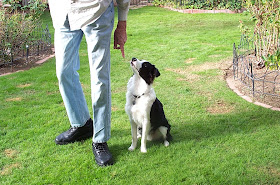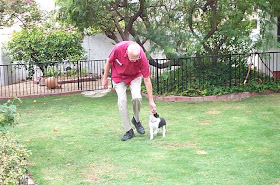When I think about training a puppy -- or a dog of any age -- for competition obedience, my thoughts default to heeling. Not to the exclusion of all the other important competition fundamentals like fronts and finishes and retrieving and sits and downs and stands and recalls. But my mental picture of the performance I'm seeking features the dog in perfect heel position, head up, eyes bright . . . lovin' it.
After all, when you walk into the Novice ring or into any of the advanced A classes, what's the first thing the judge is going to get the opportunity to assess? Heeling. That's where the judge's first opinion of a team's performance is formed. And that first impression is bound to influence how she scores the rest of the exercises.
Heeling is also where the lion's share of the attention imprint can be applied.
So in my own training, in my students' training, heeling gets high priority. There are many ways to teach heeling, but I've found that for me the best method to get the best results is AnneMarie Silverton's Pinpoint Heeling. For a little primer on Pinpoint Heeling as well as a good grounding on dog obedience in general, please refer to my series titled "Attention, Attention, Attention," posted to this blog in October and November 2011.
I start my dogs and my students' dogs off-leash. That's the way it is the very first day when we begin the puppy's little follow exercises. Then it just sort of progresses from there. Along the way I've discovered a few benefits -- not the least of which is the total absence of the horrible trauma that comes at the terrifying point where it's time to remove the leash and heel Fluffy. "Oh, my God! I haven't slept for a week!"
First of all, -- and I've found there are quite a few of like mind about this -- I regard the leash as an impediment.
Beyond that, in the traditional method of training heeling, where you are initially wedded to the leash, there are all these silly gyrations, accompanied by lots of heartburn.
I had this "shark line" on my Novice A dog, Honeybear. The idea was that it was thin; she wasn't supposed to know it was there. I wonder if she got a clue the first time I popped her?
The shark line was only batting practice for the part of the game that got really bizarre. We had
two leashes on the dog as we started out heeling. At some point, in a sequence worthy of an Academy Award, with much ceremony and extraneous clicking, we'd remove one of the leashes. Now the dog thought she was leash-free, right? Oh, I hope not! Any dog that stupid should be taught to shake, then retired to the couch.
Anyhow, less by design than by the natural progression of things, my students and I start the process off-leash. It's only later, when we want to introduce a few corrections, that we add a leash.
So in the Pinpoint Heeling scheme of things, my students and I start the process off leash. It's only later, when we want to introduce a few corrections, that we add a leash.
In the beginning, the treat, very visible between the thumb and index finger, is first on the dog's nose, then in tiny steps (SLOWLY! We're talking months here.) it moves up to waist level. And then to the attention stick.
From the tone of my earlier posts you might think all of this is a piece of cake. Tra-la! And away we go. Don't you believe it; those are little drops of blood on my forehead. If you are
not a serious dog trainer but just stumbled on this blog while looking for the latest week-after-Cyber Monday specials, know that training a dog to excel in competition obedience is exceeded only by Chinese water torture. And that's before the setbacks.
Which is where we are now in Presto!'s heeling progress. I've got the treat about three or four inches above his nose and recently his head position and his focus deteriorated. To cope with this revoltin' development, I want to introduce some leash corrections. I've had the leash on him from time to time with my hands occupied this way: The treat, Presto!'s focal point for right now, is in my left hand. The leash is in my right -- which
was in arm-being-twisted position behind my back.
That's a very awkward position when I want to administer a little pop to redirect Presto!'s attention to the treat. What's more, now I've lost the ability to use my right index finger to point to the treat as I say, "Look!"
Oh, what I'd give for a third hand right now!
Which is why I'm positive that in 10,000 years all competition obedience trainers will be born with a third hand. How often, when training your dog, have you felt the need for an extra hand? Evolution will take care of that. Trouble is, none of us will be around to benefit from it. Unless, of course, there's some way to factor in the time spent in the blind during out-of-sight sits and downs.
Way back when, in a time and place long since forgotten, someone, also long since forgotten, told me about the behind-the-back leash position. But now it was bugging me. So I went right to the source, the current doyenne of Pinpoint Heeling, Louise Meredith. I told her of my current discomfort and asked her how she handles the situation. Here's her response.
I don't like having the leash behind my back and in the right hand when I'm heeling. It's way too awkward and I can't give a proper correction. So when the treat is still in my left hand, above the dog's head, I have the leash in my right hand. My right hand and arm come across the front of my body, slightly above the level of the treat that's in my left hand. There is next to no slack in the leash and I pop up on it when the dog loses attention. The leash is tight enough so that the dog can't forge or lag. But if he does slightly forge or lag, I either pop back or forward, depending on whether it's a forge or a lag.
The conclusion to that little anecdote is simple and sweet. I've been working with the new position of hand and leash for several days now and it's just what the doctor ordered.
However, dealing with heeling focus lapses is swell, but I'm not deluding myself. There's more to this than a simple transient heeling problem.
Yesterday Presto! turned seven months old, and he's intact. There may be hormonal factors involved here. If so, there's no way they'll be an excuse. We'll train through whatever obstacles present themselves.
More to the point, I think I need to work a little harder to keep Presto! engaged when he encounters the interesting new sights, sounds and smells present in the parks where we train.
I'm working much harder to keep him Velcroed to me when we practice -- treating the entirety of each practice session as one "seamless" exercise. Stressing "right here" as we move from exercise to play interlude to exercise. In the early weeks of this mode he's getting leashed as we move from place to place. He then moves
at my side to whatever's next. No drifting away to sniff.
I'm also ramping up my practice of distracted recalls on a flexi. For me, that works best by going for short walks, allowing the dog to get distracted, then: pop/"Presto! come!/"Good come!"/ treat. I tell my students, "When the 18-wheeler is bearing down on your dog, you want him to turn on a dime and come to you. So practice distracted recalls until you are blue in the face." Right now I'm trying to get a little blue in my own face.
And of course there's a lot more play being melded into our practice sessions.
Next time we'll take up other fundamentals stuff we're working on.
Willard





